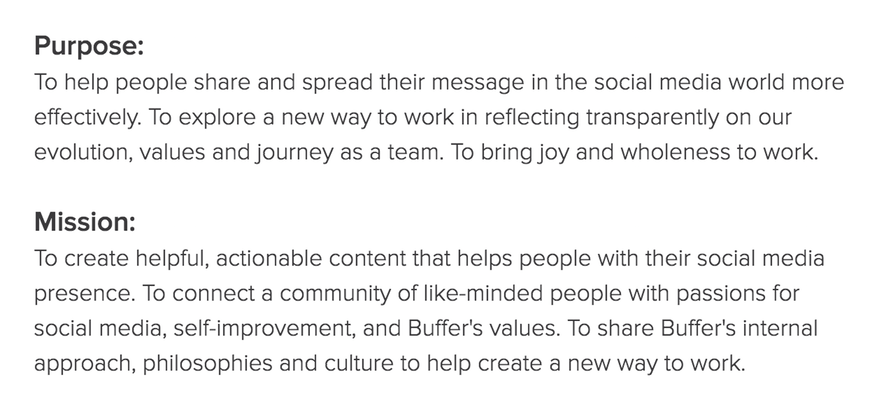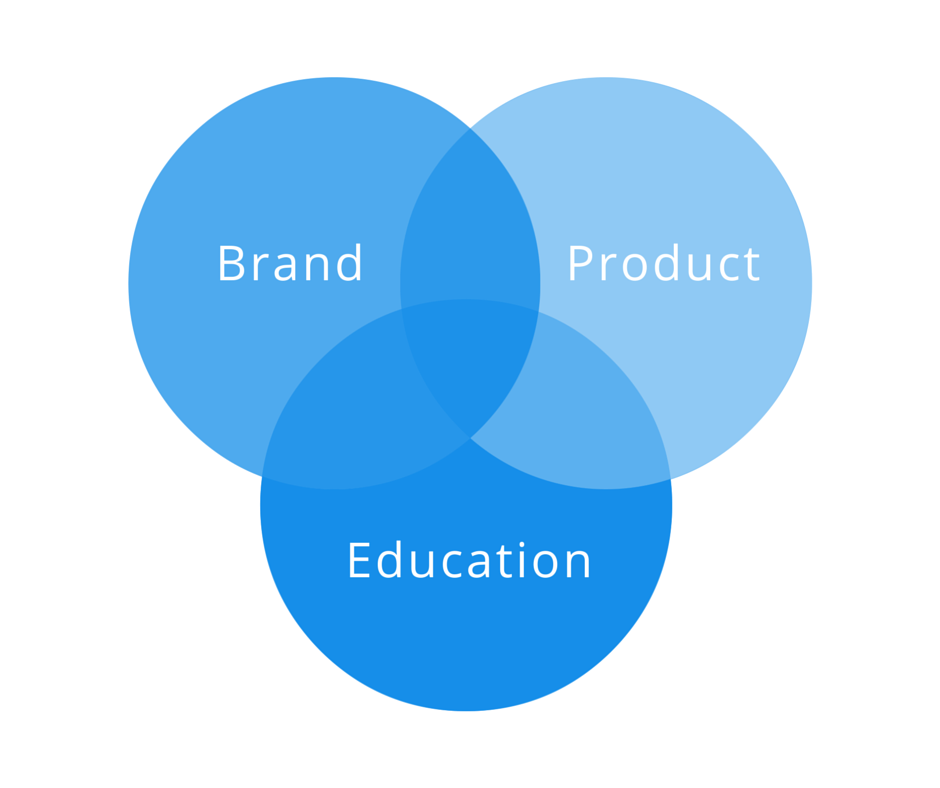Creating company culture and company values isn’t a static exercise—it’s a constant evolution.
Lately we’ve been excited to begin growing the Buffer marketing team (see the roles we have in mind!). With this growth comes the great opportunity to share with new teammates how we currently think about marketing at Buffer.
And what we found in thinking ahead to these great conversations is that our understanding of Buffer marketing is rather quite implicit.
As never larger than a team of three, we’ve always seemed to intuitively know how we do Buffer marketing.
We’ve yet to jot anything down.
On our recent retreat to Iceland, we had the chance to come together and talk things through, coming up with an early version of what we call Buffer’s marketing culture and values. I’d love to share with you our thought process here and to get your thoughts!

Defining our purpose and mission
With the move to self-management, we found ourselves in the amazing position to set forth a certain purpose and mission for our marketing efforts. Leo, Courtney, and I sat down together to come up with our current best intuition about what that purpose and mission might be.

To help arrive here, we went through a fun exercise that Courtney found over on the Crew blog in a post by Leon Jacobs. The exercise encouraged you to answer a series of questions
- Write down simply what your business does.
- Ask yourself: What’s the benefit of that? and write it down below the first statement. Ask the same question about your answer and write below.
- Keep going along the same pattern as many times as you can. Try not to give up until you have gone through at least seven iterations.
Here’s a sample of what I got when I went through the exercise for Buffer:
- What does Buffer do? Help people manage their social media profiles
- What’s the benefit of that? better results and less time spent
- What’s the benefit of that? happier and confident in their work, freedom to spend their time how they please
- What’s the benefit of that? enjoy their work, autonomy
- What’s the benefit of that? work becomes fun, choose what brings you the most joy/fulfillment
- What’s the benefit of that? no longer feels like work, freedom of choice
(I found it a bit challenging to go seven levels deep. It was a great growth moment for me!)
Creating a culture within the culture
We’re grateful at Buffer to have received some great support for our workplace culture and values, the 10 characteristics of our culture that define what we do and how we strive to live our lives.
This big-picture Buffer culture has helped inform and guide our marketing culture as well. The ideas laid forth in the Buffer culture have specific instances where they’ve been useful and impactful on content, social media, and strategy.
What we found is that particular elements of this culture resonate quite strongly with us on the marketing team.
Buffer, the company, has a unique way that it does business, guided by its culture and values.
We, as a marketing team, have a unique way that we do content and strategy, guided by certain values and ideas.
It seemed to make a lot of sense to identify and name the particular elements of our marketing culture. Here’s a bit more about that exercise and what we came up with. :)
How we arrived at our Buffer marketing culture
In coming up with an explicit definition of Buffer marketing, we first started by thinking together on what makes Buffer marketing unique. It helped to reflect on a few big questions:
- What adjectives describe a piece of Buffer content?
- How would you be able to tell a piece of Buffer content apart from a piece of content from another website or company?
- What do we strive for?
- What is important to us, personally and professionally?
- What might an article or strategy lack that would make it not quite a fit with our marketing?
After answering those questions, we came up with five values for our marketing culture.
Here’s a bit more about how we’ve arrived at these specific ways of doing marketing at Buffer.
Focus on improvement
- Educational content
- Detailed & specific
- Actionable
- Simple, clear language
What this might look like in practice:
We’ve made the purposeful decision to lean toward educational content versus entertaining content. The specific, actionable ways that we go about this come back to this idea of constant improvement—we’re learning as we go and sharing everything we find.
This often comes up in the way we write our blog posts.
- We write 1,500- to 2,500-word blog posts.
- We share detailed action steps on how you can put a strategy into place.
- We write headlines that inform rather than charm.
Choose positivity
- Optimistic
What this might look like in practice:
We recognize that there can often be challenges for folks who are starting out on social media or who are looking to take their social media to the next level. And instead of dwelling on any pessimistic outcomes, we’ve found it fits with our strategy to be optimistic and encourage our audience that it’s possible to succeed (and offer as many steps to get there as we can).
An article that comes to mind from this side of things is the one we wrote about your invisible audience, where we shared how more people see your posts than you might think.
Another way the positivity value comes through is with the ever-changing social networks. We seek to have an attitude of gratitude for things like the Facebook News Feed, which does change often and can be mysterious, but is mostly just such an ingenious, terrific aid to our finding incredible value from our friends and fans.
Set aside ego
- Humble
- Relatable
- Conversational
- Experimental
- Transparent
What this might look like in practice:
We admit to mistakes openly, sometimes even right up front in our headlines. For example: All the Mistakes We Made with Blog Images, and Everything We Got Wrong About Pinterest.
We also aim to take an experimental route with things, where we’re open to the idea that we don’t have all the answers and are curious to learn and discover. Our post about Facebook Ads felt quite in line with experimentation.
And for keeping things relatable, we seek to create content that positions us as peers with those who read it. I don’t consider myself a social media expert. I’m very happy to be learning along with everyone else and am quite similar to others in how social media affects and improves my life. Courtney does a great job of embracing this relatability in her Psychology Of … series.
Listen first
- Community-driven
- Respond to comments
- Learn from others
What this might look like in practice:
We don’t learn in a vacuum. Embracing our audience and community with gratitude is a big part of our marketing culture. Comments and conversations tend to inform a lot of our ideas for blog posts.
A guest post that we published on the blog began as a comment and turned into a really great resource about marketing websites.
And we’re happy to share the new tips that we’ve picked up by listening to our audience. This 1-pixel Pinterest tip from the community has been amazing for us!
Work smarter, not harder
- Move fast, ship things
- No need to overly perfect, polish – a good plan this week is better than a great one next week
- Update and improve as needed
What this might look like in practice:
As a small marketing team, we’re excited to produce content and resources quickly so that we can start learning from them—gaining feedback, seeing what’s worked, noticing where to improve.
Our Facebook News Feed algorithm review began as a small seed of an idea that we quickly spun into a blog post. It’s done great! And we’ve attempted to keep iterating on it with a better format and possibly even more functionality on the page soon.
Email courses are another area where we’ve moved fast, following a hunch that a course-type structure could be quite valuable for folks. We started with a 7-day course, and the next iteration is a 25-day course with video!
The three areas of Buffer marketing
Further, we’ve even noticed that Buffer marketing could extend to three somewhat distinct areas that cover the work we don on the marketing team.
The seed of this idea came from the folks at MailChimp who have a two-pronged approach to their marketing: product and brand. We feel that there’s a third side to our marketing at Buffer, so our three include product, brand, and education marketing.

Here’s a bit more about each of these.
Brand marketing
This includes promoting the Buffer culture and values—the things we’re known for besides our social media product, things like remote work and transparency. The Open blog feels like a great spot that focuses a lot on this type of brand marketing.
I sometimes like to think of this as altruistic marketing. We do the things that we feel can improve lives for us and others.
The goal here is to create a bias for Buffer … so that when the decision time comes, we have an advantage.
Product marketing
The goal here is to get people to know and understand what our product does and to support our awesome customers in meeting their needs and making them successful.
Product marketing, in my mind, is closely tied to customer happiness and support. If we’re able to help others use the product better, we must be listening for needs and areas to improve.
Some cool questions: How are people using our application and why? What ideas can we help people with so they can be successful?
Education marketing
The goal here is simply to help people succeed on social media. This one is a bit separate from product marketing as it is never explicitly about Buffer the product. Many times, the dots will connect back to Buffer, though that’s not precisely the purpose.
We simply want to help people succeed on social media by creating resources and adding value for the specific ways that would be most useful.
I like to think of the Social blog as being one of our best places for this type of education marketing.
Over to you
This is still an early version of Buffer’s marketing culture and values, and I’m sure this document will grow and evolve as we learn more. I’d love to hear your thoughts on this direction for our Buffer marketing.
Anything that catches your eye? Anything you might add, change, or highlight?
It’d be great to hear from you in the comments. I’d be keen to know if you’ve got a similar type of culture or values for the work you do for your business or brand!
Image sources: Unsplash, IconFinder
Try Buffer for free
190,000+ creators, small businesses, and marketers use Buffer to grow their audiences every month.



